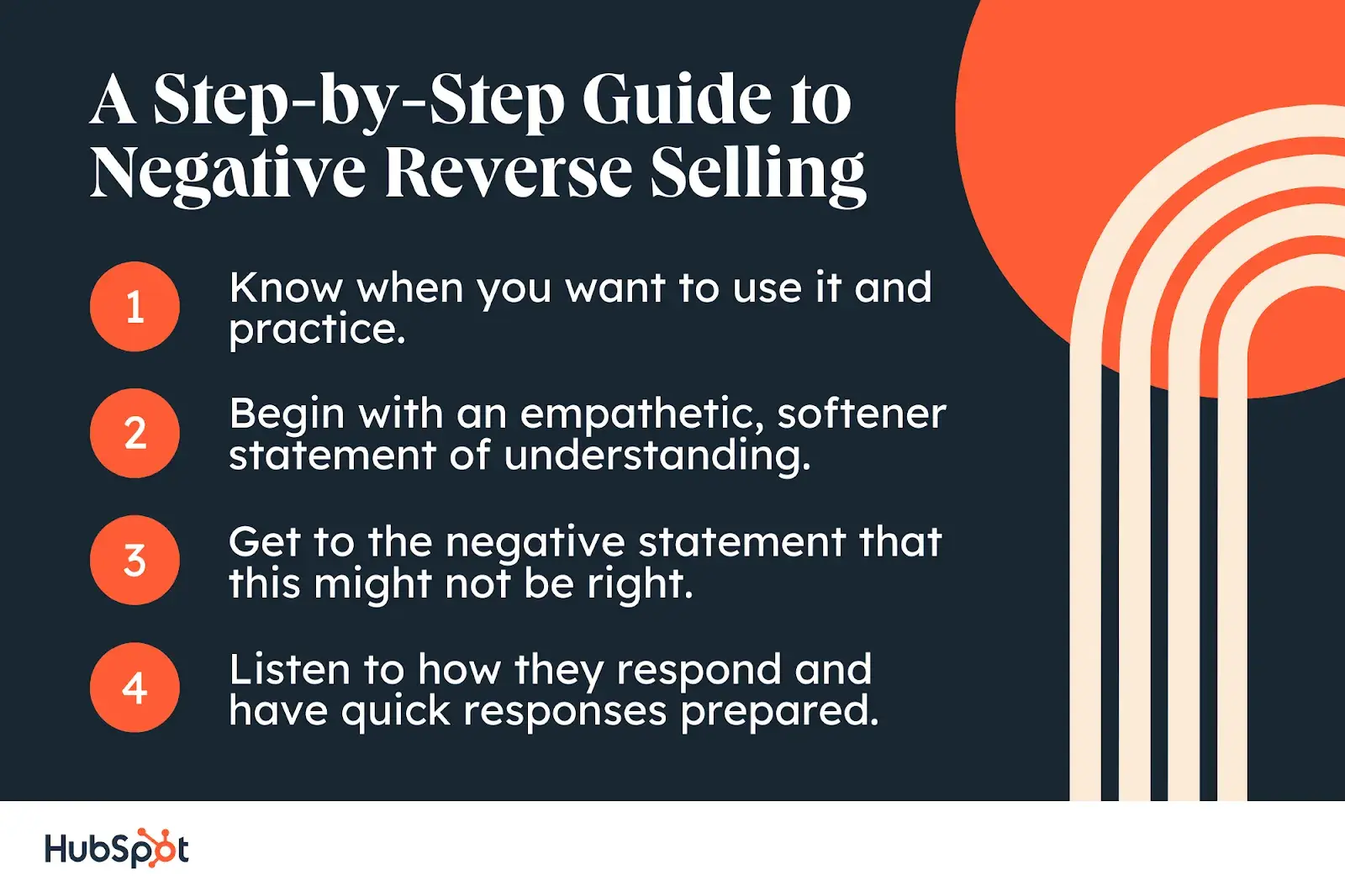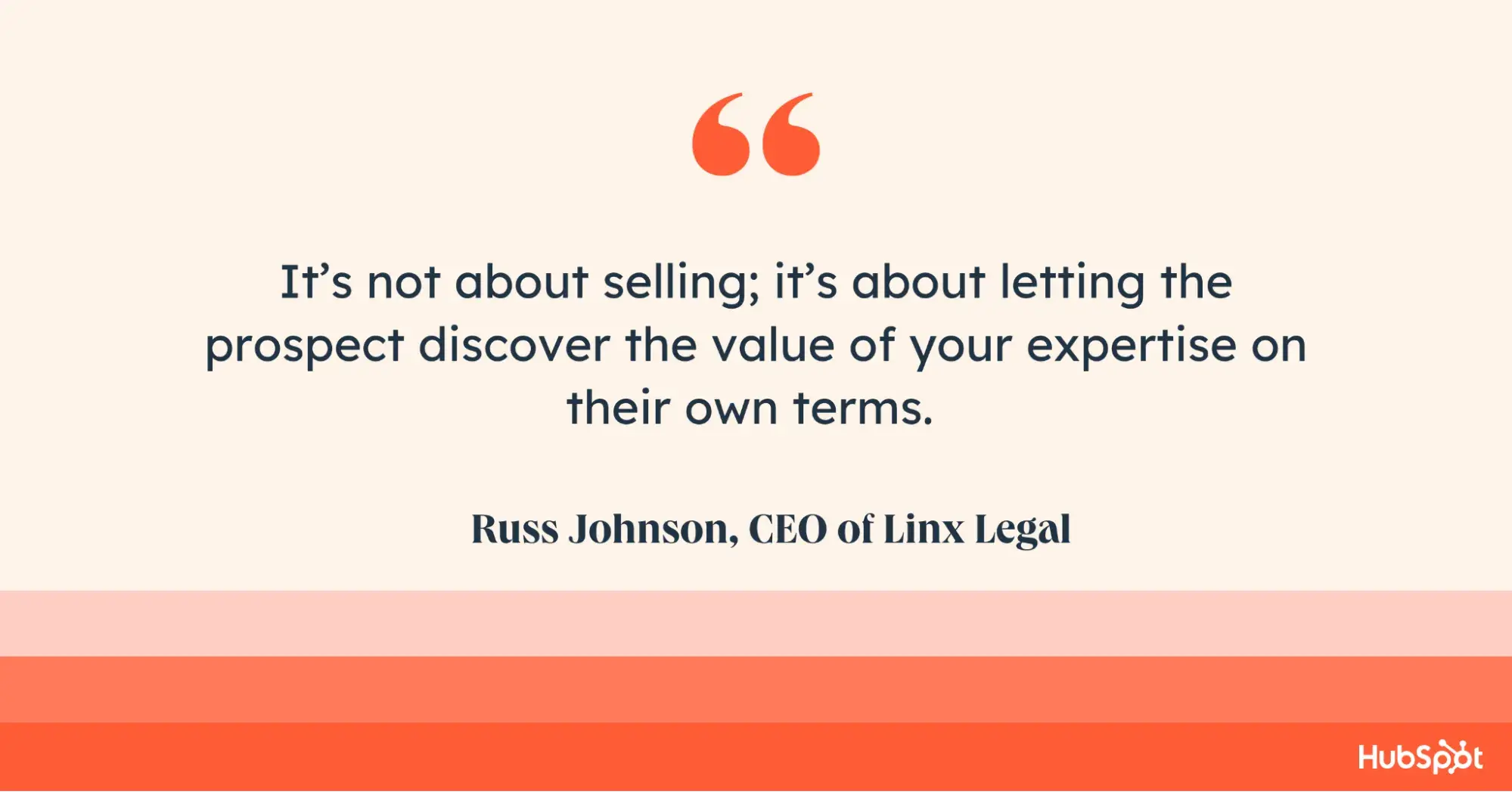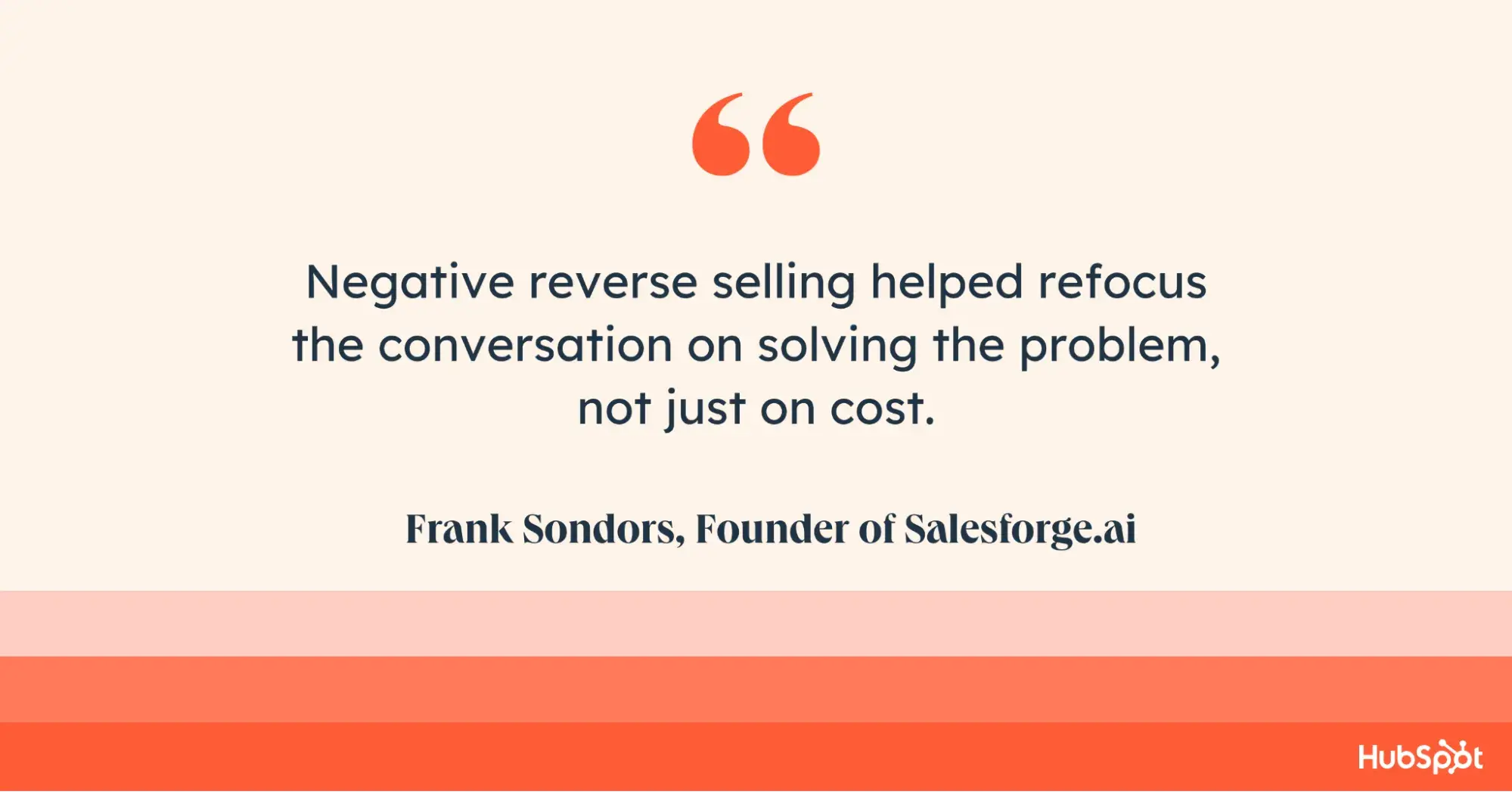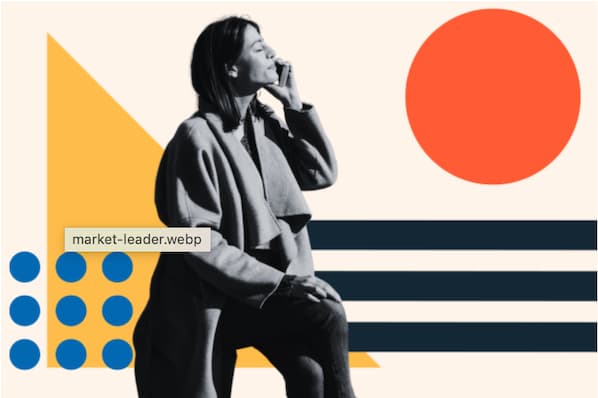Table of Contents
- What is negative reverse selling?
- Five Use Cases for Reverse Selling: Negative Reverse Selling Examples
- How to Use Negative Reverse Selling
- Handling Negative Responses
- Negative Reverse Selling Tips
- Implementing Negative Reverse Selling
What is negative reverse selling?
As I’ve mentioned, you want to get the “no” as soon as possible so you can move on. Otherwise, your prospect might drag you along for weeks or months without giving a definitive answer. I call this “Hope Island,” and it usually sounds like:
- “Hey, can you call me back?”
- “Email me, and I’ll get back to you.”
- “Hey, follow up with me next week.”
- “Sorry, I had to cancel. I’ll get back to you with a better time.”
When I hear those phrases, I know I’m screwed. I don’t want to stay on Hope Island and keep calling even though they’re probably not interested. These phrases tell me it’s time to try negative reverse selling.
Negative reverse selling is a sales strategy that focuses on reverse psychology to get a prospect to either say “no” quicker or to sell your product/service to themselves. As the salesperson, you’ll respond to objections and “fluff” responses from a prospect by telling them that it sounds like this isn’t a priority for them and maybe now isn’t the right time to purchase.
Your prospect will either agree and say they aren’t interested, or they’ll defend themselves and your product/service, convincing them to close sooner.
A word of warning: It’s easy to misuse this technique in a way that makes you seem rude. Apply it selectively — and diplomatically — making sure you never use it with someone when there's no chance of positively progressing your deal.
How does negative reverse selling work?
While you might normally want to overcome an objection a prospect has, they’re often prepared to resist your sales tactics. With negative reverse selling, you’ll end up agreeing with your prospect and then employing reverse psychology to get them to convince themselves to buy your product.
Let’s use a quick example to see what this might look like in conversation.
- Prospect: We want to see immediate results, and that’s our biggest concern.
- Salesperson: I understand; that makes sense. This product is really for those looking to grow their business in the long term instead of using short-lived tactics for immediate results. This might not be the right fit for you. Is it fair for me to assume that’s the case?
- Prospect: Well, we do want to grow in the long term, and we want to use tactics that will help us grow continuously.
Do you see how the prospect in this conversation tried to convince you that they are a good fit for your product/service? That’s the reverse psychology in negative reverse selling.
If a prospect doesn't respond by trying to convince you they’re a good fit, they’ll say something like, “You’re right. This isn’t a good fit,” which helps you get to a “no” quicker.
You want to call out your prospect’s lack of interest and get them to admit the answer is “No” without going too negative. Essentially, you’re getting them to realize they’re bluffing.
That’s it. This single framework saves countless hours. Adding in a phrase like “Is it fair for me to assume that’s the case?” gently pushes prospects to answer more honestly about their interest in your product.
Where did negative reverse selling come from?
Negative reverse selling is a tactic in the Sandler Selling System, developed to focus on having sales reps act more as consultants rather than the “pushy used-car salesman” stereotype.
The whole idea behind the Sandler strategy is to concentrate on asking the right questions during the qualifying process instead of pushing a product on someone who doesn't need it.
Why does negative reverse selling work?
Negative reverse selling works because people resist being “sold” on something. They worry that they’re being lied to or swindled. With negative reverse selling, it’s apparent that the sales rep is not trying to do that. Instead, reps want to help the prospect solve their problem. It’s a more human approach to sales.
It pushes a prospect to talk more about their objections and work through them on whether this purchase is a priority. Plus, it helps them go over the “pros” of your product or service through reverse psychology. They discover the solution themselves.
For example, let’s say you tell a prospect, “It’s probably not a good idea right now,” or “I’m not sure you’re ready,” or even “I don’t think we have what you need.” Their response will be to defend themselves and argue why it’s a good idea, why they are ready to move forward, etc.
And, of course, if their answer is actually “no,” it’s better for you to know sooner than later so you can move on to other deals.
Five Use Cases for Reverse Selling: Negative Reverse Selling Examples
Now, let’s review some situations when you can use negative reverse selling as a sales rep.
1. Deal-Breaker
- Prospect: We need your product/service to help us with every aspect of marketing for a lower cost, not just advertisements. That’s a deal-breaker for us.
- Salesperson: I understand. Typically, when needs and budget don’t align, it means you might not be ready to make the jump to our type of product. Is it fair for me to assume that’s the case here?
- Prospect: Well, no. We are ready for the full product now, so maybe our budget isn’t realistic.
Why negative reverse selling works in this scenario: This strategy will work when a prospect presents a deal-breaker because they’re usually trying to see what they can get away with in terms of negotiation. However, this flips the script and is the opposite of what the prospect expects to hear.
What I like: In this scenario, I like how the salesperson doesn’t say what’s expected. By causing that break in the conversation, the prospect has to really think about whether they’re serious about buying your product/service. And usually, they end up trying to convince you why they’re ready to make a purchase now.
2. Dragging Their Feet
- Prospect: Can you email me, and I’ll get back to you? And maybe follow up next week as well?
- Salesperson: I can do that. But usually, when this happens, we’ll play phone tag, and it’s not the right time for you to purchase. Should I assume that’s the case here?
- Prospect: You’re right. We’re just not ready to make this decision yet.
Why negative reverse selling works in this scenario: In this case, negative reverse selling works because you get to that “no” a lot quicker than when you have to reach out continuously to a prospect that most likely won’t purchase.
What I like: Here, I like that the salesperson cuts the BS and saves time when a prospect isn’t serious about buying your product/service. It’s helpful to get to the “no” as quickly as possible so you don’t waste your time trying to sell to someone who isn’t ready.
3. Objections to Price, Timeline, or Delivery
- Prospect: We need your product/service to deliver results quicker than promised.
- Salesperson: I understand. Typically, when timeline and short-term tactics are prioritized for a client, it means you might not be ready to move our type of product. Is it fair for me to assume that’s the case here?
- Prospect: Well, no. We want results, and we’re willing to use long-term tactics to get there.
Why negative reverse selling works in this scenario: When a prospect has an objection to price, timeline, or delivery, this strategy works because it puts you in the consultant chair, which is the entire basis of the Sandler sales methodology. It shows that you’re trying to help a client figure out what’s right for them, and they’ll work through their objections themselves.
What I like: This approach during an objections conversation can help educate a client on what expectations are realistic and will work for them.
4. Canceling and Rescheduling
- Prospect: Sorry, I have to cancel our meeting again, but I’ll get back to you with a better time.
- Salesperson: Okay, [client name]. I understand things happen, but typically, when a client needs to reschedule a meeting several times, it means now isn’t the right time. Can I assume that’s the case here?
- Prospect: No, we’ve just had a lot going on. Let me get you in contact with someone else on our team who has more time to meet.
Why negative reverse selling works in this scenario: This will help a client either say that they aren’t ready to make a purchase or maybe put you in contact with someone who won’t reschedule and has more time to meet with you.
What I like: Similar to the dragging their feet example, I like how this approach to someone canceling and rescheduling a demo meeting or consultation cuts the excuses. Do they even have time for this conversation? If not, maybe there’s someone else you can talk to.
5. ‘We’ll think about it’
- Prospect: Alright, this was a lot of great information. We’ll think about it and get back in touch.
- Salesperson: Okay, [client name]. Typically, when I hear “we’ll think about it,” it means that a client isn’t interested in our product/service. Can I assume that’s the case here?
- Prospect: Yes, you’re right. We aren’t going to make a purchase.
Why negative reverse selling works in this scenario: This scenario helps you get to that “no” as quickly as possible. As the sales rep, you can tell when a “We’ll think about it” is serious or isn’t. Use negative reverse selling if you know they aren’t interested, and save yourself some time.
What I like: This approach will save time and is up to the discretion of the salesperson to determine if a prospect is actually interested.
Now, let’s learn how to use reverse selling and handle negative responses.
How to Use Negative Reverse Selling

1. Know when you want to use it and practice.
The first step is to know what situations you want to use the strategy for. Will you implement it on deal breakers, objection conversations, or both? Then, you should practice with your colleagues to ensure you have the right cadence.
It isn’t easy to tell a prospect that you don’t think your product is a good idea, and it could have negative results. That’s why you’ll want to practice incorporating this strategy and know when you want to use it.
And get comfortable using it in your target situation before applying it to other objections or roadblocks. Before you know it, you’ll use it instinctively when faced with one of those fluffy “maybe” answers.
2. Begin with an empathetic, softener statement of understanding.
Once you’ve decided that you’re going to use this strategy, it’s time to begin writing your script. You’ll want to start with an empathetic softener statement of understanding.
Did you notice how, in all our examples, we began with “I understand” or “That makes sense”? That helps the prospect feel understood and listened to. Then, that’s when you’ll jump into the negative statement.
3. Get to the negative statement that this might not be right.
After a soft opening, say why you think this time might not be right for the prospect or ask for specific clarification to see if they’re actually interested.
4. Listen to how they respond and have quick responses prepared.
Your prospect can have many responses, so have your script prepared. What will you say when they try to convince themselves to purchase your product? Or what will you say if they say they aren’t interested? Or how can you respond if they have a negative reaction and are upset by your statement?
It’s important to be prepared for any type of reaction from your prospect.
Handling Negative Responses
Negative reverse selling isn’t a tactic to use all the time, but there are situations where this type of reverse psychology will work. It’s important to keep it in your back pocket should the situation arise.
Negative reverse selling works because you push back on a prospect's fluffy response and ask for a specific answer. From there, you can agree to touch base in six months or when the client is ready. Either way, you can move on to other deals, and your prospect can return to their work without worrying about the next time you’ll call.
If you use this approach, be ready for a few prospects to get angry. They still don’t want to tell you no, so some prospects will lash out. Here’s an example:
- Prospect Sam: I’m headed into a meeting; can you give me a call next week?
- Salesperson: Sam, I’ve tried to connect a few times now. Typically, when this happens, it means this is a low priority for you at the moment. Is it fair for me to assume that’s the case?
- Prospect Sam: Well, if you don’t want to talk to me, then I’d rather not do business with you.
- Salesperson: Hey Sam, my apologies. I do want to talk, but I feel like I’m driving you crazy here with all these voicemails and missed calls. I’d hate to keep bothering you if it’s not necessary. It might be best if you reach out when it’s a better time.
This last line is important. You must be clear that you’re keeping the conversation positive and centered around your prospect’s well-being.
It should never feel like you’re taking revenge on an uninterested prospect by saying, “You always say you’ll call me back, Sam,” which turns the conversation into an accusation and, sometimes, an argument.
By keeping things constructive, you’ve put the negativity on yourself instead of on the prospect. It’s important to stay professional and remember you’re speaking to your prospect in a way they’re not used to hearing from salespeople.
In the conversation above, you can leave Sam your contact information and reiterate that you’d love to open the conversation when it’s their priority. This way, you’re no longer caught in the hamster wheel of calling and hoping Sam suddenly becomes interested.
We’ve discussed when to use the negative reverse selling technique and various use cases, but how can you implement this strategy? Below, I’ll give you a step-by-step guide on incorporating this strategy into your sales calls.
Negative Reverse Selling Tips
To move beyond theory, I decided to dive into practice and interview experts who revealed the tips that work best for them, along with real-life examples.
Turn ‘not now’ into opportunity.
“Not now” doesn’t mean no forever. Sometimes, all it takes is a little patience and a shift in approach to turn hesitation into a long-term opportunity. Step back when a prospect says they’re not ready and give them the space to reconsider and, in many cases, reveal what’s really holding them back.
I talked to Peter O’Callaghan, head of marketing at ScrapingBee, about how he turned a “not now” into a successful partnership.
“In one instance, a prospect from an insurance company hesitated, claiming they were managing fine with their in-house data tools. I responded calmly, ‘I understand if this isn't a priority for you right now.’ This neutral response broke the tension,” O’Callaghan says.
Was it worth it? Absolutely.
“Instead of ending the conversation, they explained the exact challenges they faced with their tools. We shifted the discussion to how ScrapingBee could solve those pain points more efficiently. By addressing scalability, we cut their onboarding preparation from 6 weeks to 3,” O’Callaghan continues.
O’Callaghan notes that this approach not only improved their team’s workflow but saved them approximately 10 hours weekly on manual adjustments. “That small adjustment led to an agreement that has grown into one of our most fruitful partnerships,” O’Callaghan says.
Use doubt to spark curiosity.

Instead of directly trying to convince a prospect, you gently challenge their assumptions with thoughtful questions. This approach gets the prospect to rethink their needs and often helps them realize the value of your solution on their own, without feeling pushed. It’s a strategy that builds trust and lets the prospect come to their own conclusions (and that's exactly what you should be striving for).
Russ Johnson, CEO of Linx Legal, shared how this tactic has transformed his sales approach.
In a recent conversation with a prospect exploring legal services to manage their contracts, the prospect said their team was fine handling everything in-house for now.
“I responded, ‘That’s completely fair; many businesses feel that way. But sometimes, in-house teams find it tough to keep up with the nuances of ever-changing regulations. How confident are you that your team has the bandwidth to monitor those updates consistently?’" Johnson says.
The prospect paused, then admitted they hadn’t considered the constant regulatory shifts. This opened up a deeper discussion about the gaps in their current approach and how Linx Legal could fill them.
Johnson pointed out, “It’s not about selling; it’s about letting the prospect discover the value of your expertise on their own terms.”
Challenge the “perfect fit” mindset.
Sometimes, prospects hesitate because they believe they need a solution that’s a “perfect fit” for their business. This mindset can cause them to overlook a product that could solve their current challenges. A great way to shift this thinking is by challenging the idea of perfection and focusing on addressing their immediate needs instead.
I talked about this with Carl Jacobs, co-founder and CEO of Apicbase. Jacobs notes that he had to refine his sales techniques what he said to navigate tough conversations and win over hesitant prospects, especially in the competitive food and beverage technology space.
“In a recent conversation with a prospect, they said, ‘Your software looks great, but I’m not sure it’s exactly what we need right now.’ I responded, 'You’re absolutely right; Apicbase might not be the perfect solution for every restaurant or F&B business,’” Jacobs says.
However, according to Jacobs, perfection can sometimes delay solving the real issues at hand. “For example, ‘Have you found a way to cut food costs without adding hours of manual work to your team’s plate?'" Jacobs says.
Jacobs explained that this approach works because it lowers their defenses while subtly shifting the focus to the problem at hand. In this case, the prospect admitted they hadn’t yet tackled food cost management effectively, which opened the door for a conversation on how Apicbase’s software could help.
As Carl put it, “Progress often beats perfection.”
Shift focus from cost to solution.

When prospects raise concerns about the cost of a solution, it's easy for the conversation to get stuck on price. But don’t let that throw you off. One effective way to handle this is shifting focus from cost to the real value your solution brings.
Frank Sondors, founder of Salesforge.ai., says he has used negative reverse selling to turn price objections into valuable conversations.
“For instance, if a prospect says, ‘Your solution is too expensive for our budget,’ I might respond, ‘If price wasn’t a concern, do you believe our solution would help solve your problem?’ This forces the prospect to rethink their objection and focus on the real value we’re offering,” says Sondors.
This resulted in exploring alternative pricing models and a sealed deal.
“Negative reverse selling helped refocus the conversation on solving the problem, not just on cost,” Sondors added.
Let prospects convince themselves.
Speaking of concern called “high cost,” another effective strategy is to let the prospect compare your solution to others in the market. By doing so, you‘re not pushing your product directly — you’re guiding them again to realize the value themselves.
Your sales rep can simply respond that they would offer a cheaper alternative product from a competing company. And then can call out some disadvantages of that like lacking customization, etc.
It actually helped me secure sweat deals when I was leading Signum AI’s sales team.
The tactic gets prospects to reconsider their priorities and convince themselves that price isn’t a problem.
Implementing Negative Reverse Selling
When reps are trained on how to use this approach, it’s important to stress that you should use it delicately. It’s not a catch-all tactic or one you should build your sales strategy around. It should only be applied when nothing else works.
Pick the one situation you keep getting stuck on. If you repeatedly have prospects who schedule a meeting, cancel, push it back two weeks, and cancel again, implement the negative reverse approach there.
As salespeople, sometimes we have to force hard conversations and save both sides valuable time. Use the negative reverse strategy, and turn “Maybe” into “Yes” or “No” before two-week follow-up calls eat away at your calendar and quota.
Sales Methodology






![I Learned How Sales Champions Drive Deals Forward — Here’s What You Should Know [+ Recent Data]](https://53.fs1.hubspotusercontent-na1.net/hubfs/53/sales-champion-1-20250110-9355712-1.webp)
![Decoding Buying Signals in Sales [+ Examples & What I Learned]](https://53.fs1.hubspotusercontent-na1.net/hubfs/53/buying-signals-1-20250501-3647992.webp)



-3.webp)
